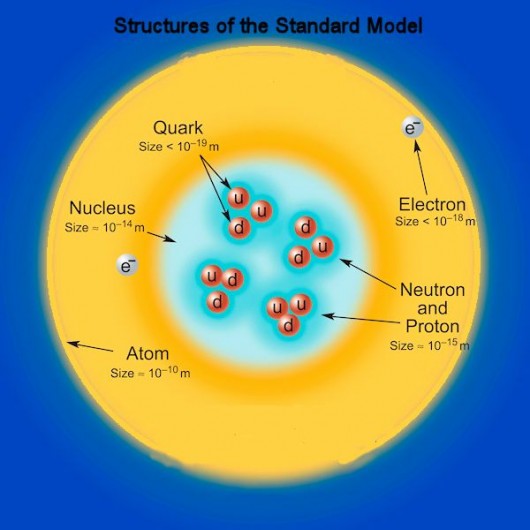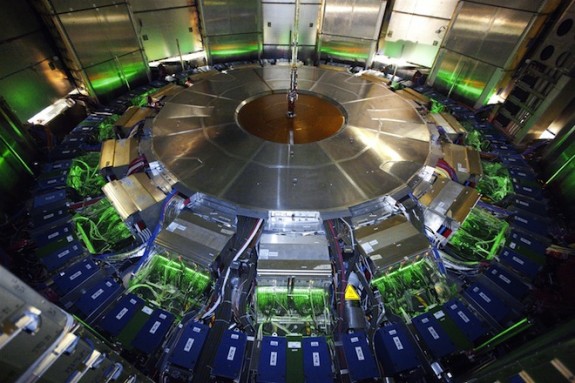The elusive Higgs Boson, in it’s likely discovery, seems only to add to its own mystery and reveals new gaps in our knowledge of the clockwork of the Universe.
From Wired.com
Higgs Hiccup: Contradictory Results Show Up at LHC
By Adam Mann
12.14.12Something slightly odd seems to be going on with the Higgs boson. Separate measurements of its properties are showing two slightly different masses, according to scientists who presented their latest data on Dec. 13.
Ever since physicists found a particle that looks very much like the Higgs boson in July, they have been probing its properties, essentially running their experimental hands all over it to check out its features. They do this by smashing protons together at insanely high speeds in the Large Hadron Collider and watching the resulting rain of particles that gets produced. Within this melee, several Higgs bosons appear and almost immediately decay into other particles.
The LHC can detect the Higgs decaying in two different ways. One channel produces two characteristic photons while another creates four particles known as leptons. The two decay paths each give scientists a distinct value for the mass of the Higgs. But there’s a little problem.
“There turns out to be a slight tension between the two masses,” said physicist Beate Heinemann of the University of California, Berkeley, who works on ATLAS, one of the LHC’s Higgs-searching experiments. “They are compatible, just not super compatible.”
The two photon channel is saying that the Higgs mass is 126.6 gigaelectronvolts (GeV), or about 126 times the mass of a proton. The four lepton decay route suggests the mass is 123.5 GeV. A very tiny disagreement that is nonetheless very strange because the Higgs should have one identifiable mass. ATLAS scientists noticed the discrepancy in their data previously and thought it might simply be a problem with calibrating their machinery. Yet even after calibration and analyzing more data, the difference remained.
Several physics blogs have noted that one way to explain this would be to have two different Higgs bosons, each with a very similar mass. This would be a truly bizarre and unexpected result. But it’s much more probable that scientists are seeing a statistical mirage.
Heinemann said the four lepton channel has only analyzed about 10 Higgs bosons and the two photon channel about 500 Higgs. Physicists need to see the same result over and over in thousands or even millions of particle events before they are sure it’s not just a statistical coincidence. “The most likely explanation is that it’s one particle,” said Heinemann.
The LHC’s other Higgs-searching experiment, CMS, has been measuring the particle’s mass as well and so far is showing a value of about 125 GeV, which agrees with ATLAS within the two experiments’ resolution. Everything seems to be pointing to a fairly well-behaved Higgs boson that has no hints of physics beyond the Standard Model, the framework that explains the interactions of all known particles and forces. The slight discrepancy is all par for the course in the business of physics discovery. We’ll have to wait to see how it plays out when the LHC scientists present their next round of data and analysis at the Moriond conference in March.
For those catching up, the Higgs Boson is actually where subatomic particles interact with the predicted Higgs Field and acquire mass. Without that interaction they are just energy.
So in slightly more lay terms from GizMag.com
What else could the new particle be? There are other version of the Higgs interaction giving mass to particles. If the new particle does not decay into tau leptons, that would suggest that its interaction with tau leptons is rather weak, and also that it is not responsible for their mass. Perhaps the new particle is only the Higgs boson for bosons, but some other particle gives the fermions (electrons and leptons) their mass. This is in line with the original formulations of the Higgs field, which was to only explain how bosons got their mass.
This answer would require an extension of the Standard Model, probably in the direction of supersymmetry. Supersymmetry relates elementary particles of one spin to other particles called superpartners that differ by half a unit of spin. Supersymmetry is only one possible theory that would extend the Standard Model, but it is particularly interesting in that it offers possible solutions to numerous problems. An explanation for dark matter (80 percent of the matter in the universe) is among the benefits.
In the 1950’s B movies, aliens came to Earth to warn us about tampering with the atom, or tried to destroy us pre-emptively for their own protection. Now that we are closing in on finally disassembling the atom, who knows what alarm bells our discoveries at this level may set off in aliens’ twisty little gray minds, both cinematic and real? And who knows how much closer we come to going out and meeting them. If mass is the issue in exceeding the speed of light, what will we become capable of if we can temporarily remove mass from the equation?
Whatever the outcome, I have to say,
Ain’t it cool what you can do with magnets and lasers?!






